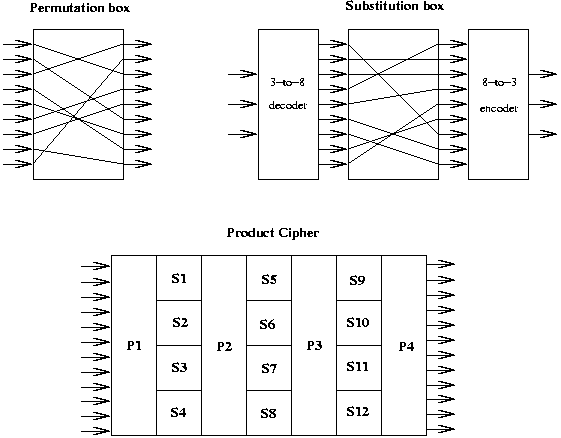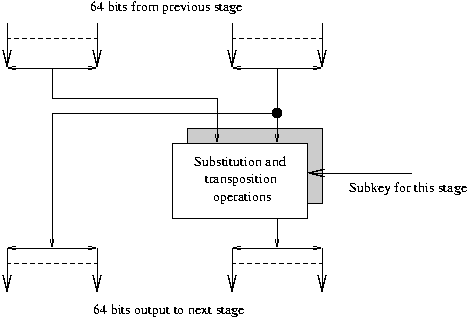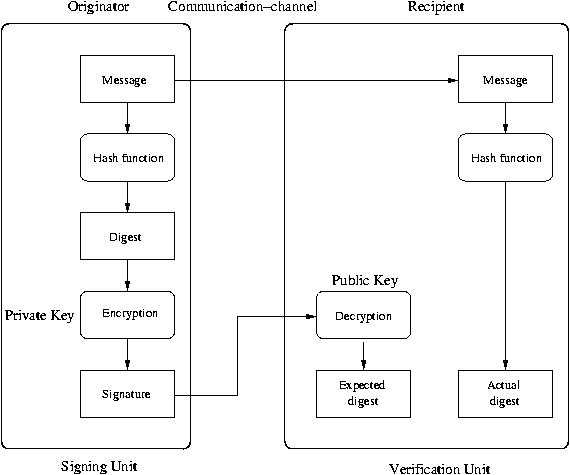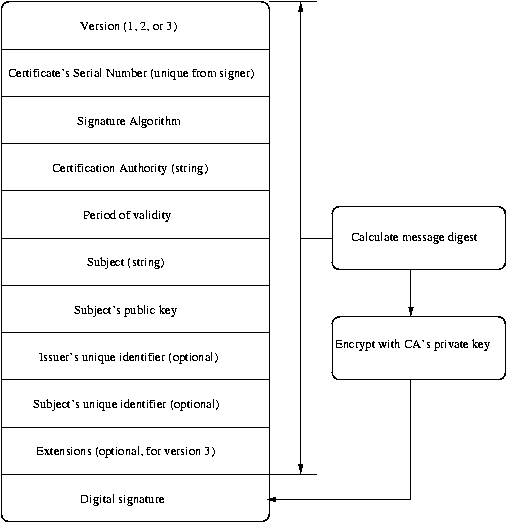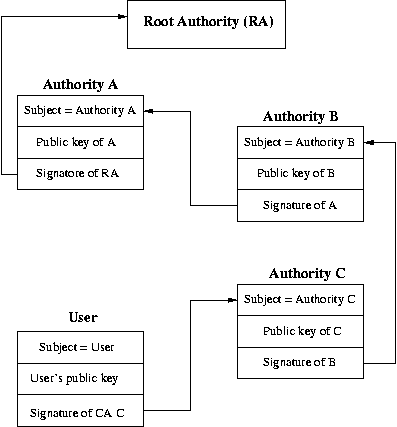The ISO/OSI Security Architecture
"Remote exploit + local root exploit ⇒ remote root exploit."
Olde saying handed down through the ages.
|
As well as defining their seven-layered model,
the ISO/OSI group also defined a range of terminologies forming their
ISO/OSI Security Architecture.
It includes the requirements:
- data confidentiality - protects data as it traverses the
network from being disclosed to incorrect parties.
Even the presence of particular communication sequences between parties
should not be identified.
- data integrity - protects the data from modification or
removal while in the network,
- data origin authentication - validates the sender of the data,
- data receiver authentication - validates the receiver of the data,
- peer-entity authentication - validates all network
components, such as hardware routers and peer software components through
which a data stream must travel, and
- non-repudiation - creates and verifies evidence that the
claimed sender sent the data,
that the intended receiver did receive it,
and that neither can deny that this occurred.
NOTE: the core TCP/IP internetworking suite meets none of the
requirements of the ISO/OSI Security Architecture.
Support for additional services is evolving,
primarily at the Application Layer,
but changes cannot be easily made to lower layers.
CITS3002 Computer Networks, Lecture 12, Cryptography's role in networking, p1, 22nd May 2024.
Cryptography's Role in Networking
"Cryptography is the science of making the cost of improperly
acquiring or altering data greater than the potential value gained.
The value of information usually drops with time, and cryptography
makes the time required to obtain data in unauthorized ways long
enough to decrease its value well below the money spent on obtaining
it."
Jalah Feghhi, Digital Certificates
|
The need for cryptography to provide security arises with the possibility of
stolen hardware,
wiretapping,
the broadcast mechanisms of LANs and WLANs,
and network traffic passing through foreign networks.
We assume that an adversary is able to :
- Copy data from disk storage for remote analysis,
- Passively listen (only) on broadcast channels
(such as wired-Ethernet and WiFi),
- Aggressively monitor traffic though intermediate routers or
workstations (situated anywhere on a message's path),
- Actively replay, modify or insert their own messages into the
message stream.
Cryptography provides solutions to most of these problems.
So where should the encryption be performed?
- Users encrypting individual files stored in a standard file-system,
- File-systems encrypting all data before writing it to disk,
- Datalink and Network layers: in switches and routers (e.g. VPNs),
- Session Layer: with end-to-end data conversion (e.g. SSL),
- Application Layer: in programs such as email agents (e.g. PGP).
CITS3002 Computer Networks, Lecture 12, Cryptography's role in networking, p2, 22nd May 2024.
Basic Cryptographic Terminology
We use an encryption function and a key to convert the
plaintext (the input) into the ciphertext (the output).
The intended receiver hopes to
quickly and correctly reverse the process -
something that adversaries should be unable to do.
We assume that the adversary knows the encryption function (process)
being used, and that the key is secret and changed frequently.
The key length is expressed in bits:
| Technology |
Key lengths |
Possible keys |
Key length |
| ATM PIN |
4 decimal digits |
10,000 |
14 bits |
| old-style Unix passwords |
8 characters |
1268 = 6.3x1016 |
56 bits |
| Unix passwords with MD5 |
any number of characters |
unlimited, though duplicates |
128 bits |
The following attacks against cryptography are common.
Each has the goal of determining the cryptographic key(s),
so that existing data may be exposed,
or future messages decrypted without the repeated effort:
- Known plaintext attack -
the cryptanalyst
(fancy name for an adversary with a Maths degree) has (or determines)
a block of plaintext and its corresponding block of ciphertext.
This may seem unlikely,
but regularly exchanged encrypted messages have fixed or
predictable payloads (e.g. email headers, VPN-session establishment).
- Chosen plaintext attack - the cryptanalyst can have their
intended victim unknowingly encrypt fixed, known blocks of data.
- Differential analysis - a kind of plaintext attack
involving many very similar plaintexts being encrypted,
and their resulting ciphertexts being compared.
If there is no separate integrity check on the encrypted data -
an attacker may be able to alter it so that it decrypts to data of the
attacker's choice.
CITS3002 Computer Networks, Lecture 12, Cryptography's role in networking, p3, 22nd May 2024.
Simple Substitution :
Caesar Cipher : ch = (char)((ch + K) % 26);
PT : abcdefghijklmnopqrstuvwxyz
CT : DEFGHIJKLMNOPQRSTUVWXYZABC
Here K = 3.
Monoalphabetic Substitution :
Each symbol maps to some other symbol.
The key is simply a 26 letter string from the alphabet.
PT : abcdefghijklmnopqrstuvwxyz
CT : QWERTYUIOPASDFGHJKLZXCVBNM
Here there are 26! = 4x1026 possible keys.
At 1msec per solution, a brute force approach would take 1013 years.
However, in English and many other natural languages,
text statistics are available on the most frequently
used letters, (262) digraphs,
(263) trigraphs and words.
To break simple codes we :
- count frequencies of each letter and match e's, t's, etc.
- count digraphs
(th, er, on, an, re, he, in, ed, nd, ha, at, en, es, of, or...)
and trigraphs
(he, and, tha, ent, ion, tio, for, nde, has, nce...)
- match th, the, in, and, ...
The movie Windtalkers
focuses on the use of the natural language of
Navajo Indians
as a code in WWII.
Speakers of Klingon
claim that their language is, for other reasons, indecipherable
(in practice).
CITS3002 Computer Networks, Lecture 12, Cryptography's role in networking, p4, 22nd May 2024.
The Influence of Computers on Cryptography
The first role of computers was to gather statistics and
perform 'brute-force' searches of ciphertext using some heuristics.
Traditionally,
convoluted,
obscure,
and undisclosed algorithms requiring long keys were used to encrypt text.
More recently the focus has changed to support simple,
open algorithms,
but with complex 'solutions'.
The algorithmic inverses themselves are intended to be so complex that
brute-force techniques take millions of years to succeed.
- An algorithm's strength is not simply derived from its keys' length,
but from its peer evaluation and public review.
- A weak algorithm is one whose algorithm and implementation are
not available, and whose strength would be compromised if these were made
public.
In 1883
Auguste Kerckhoff
stated as one of his six axioms of cryptography:
|
"If the method of encipherment becomes known to one's adversary,
this should not prevent one from continuing to use the cipher as long as
the key remains unknown."
|
CITS3002 Computer Networks, Lecture 12, Cryptography's role in networking, p5, 22nd May 2024.
Symmetric Ciphers
The Data Encryption Standard (DES, 1976)
is known as a symmetric cipher, often
a private key algorithm -
in which the sender and receiver use
the same key that must be kept private.
In general, longer keys provide stronger encryption, but it is a mistake
to imply the strength of an encryption algorithm in terms of bits alone.
Brute force attacks are the most successful.
Some popular examples of symmetric ciphers:
- DES:
a block based cipher of 64bit blocks in,
64bit blocks out, 56 bit key filled to 64bits (8 odd-parity bits).
- Triple-DES: encrypts the same plaintext with DES three times.
Three or two keys are provided, the plaintext is encrypted with the 1st key,
decrypted with the second, and finally encrypted with the third (or 1st
again).
A double-DES scheme (with only 2 keys) does not require 22n
brute-force tests but 2n+1
tests with a meet-in-the-middle attack.
- Ron Rivest's RC2 block cipher employs keys up to 1024 bits,
and executes at a speed independent of key length.
- Ron Rivest's RC4 stream cipher
(as used in WiFi's WEP encryption)
employs keys of 40 to 256 bits,
but has the property that if two messages are encrypted with the
same RC4 key,
their encryptions are related in a known way.
CITS3002 Computer Networks, Lecture 12, Cryptography's role in networking, p6, 22nd May 2024.
The DES Algorithm
As an example of the first official
deployment of encryption, we'll consider
the Data Encryption Standard, DES.
In 1977 the US Government adopted a product cipher from IBM and later that
year was defined as as the official encryption standard by the US
Standards Bureau.
DES software is publicly available
(see
DES-crypt.c),
but is more efficiently implemented in hardware.
Users are confident of its security (they will openly say when it is in
use - for example, Unix passwords).
- Data is encrypted in 64 bit blocks.
- Ciphertext is output in 64 bit blocks.
- A 56 bit key is used.
- The same key is used for both encryption and decryption.
CITS3002 Computer Networks, Lecture 12, Cryptography's role in networking, p7, 22nd May 2024.
Product and Substitution Cipher Boxes
Each 'box' is parameterized by the pairings of input->output wires,
and each input->output mapping in invertible.
An algorithm is, then,
further parameterized by the arrangement of P- and S-boxes,
and is also invertible.
The Substitution Stages
CITS3002 Computer Networks, Lecture 12, Cryptography's role in networking, p8, 22nd May 2024.
The Steps of the DES Algorithm
The algorithm has 19 steps for encryption; decryption simply performs the
steps in the reverse order.

|
What are the steps of this magic function f?
- E := R1 (which is 32 bits) expanded to 48 bits.
- D := XOR(E, Ki).
- Divide D into 8x6 bits;
feed each of these 6 bits into a different S box each producing 4 bits.
- Feed these 8x4 bits (= 32 bits) through a P box.
How is the DES key used?
- K0 := 56 transposition cipher of K.
- Divide K0 into 2x28 bits.
- ROLeft each part.
- Ki := 56 bit transition of the number formed.
|
CITS3002 Computer Networks, Lecture 12, Cryptography's role in networking, p9, 22nd May 2024.
Triple DES
DES is still in use today, in an extended form called triple-DES, or 3DES.
Whereas the original DES used only one 56-bit key,
3DES uses up to three 56 bit keys (plus one parity byte)
in order to increase the difficulty of breaking the cipher:
3DES_encrypt(key1, key2, key3, message) =
DES_encrypt(key1, DES_decrypt(key2, DES_encrypt(key3, message)))
|
The encrypt-decrypt-encrypt approach is used to make the algorithm
compatible with single DES,
in the special case when key1 = key2 = key3.
DES under Unix in software
A number of routines are provided which are typically used for encrypting
passwords and files.
char *crypt(char *key, char *salt);
setkey(char *key);
encrypt(char *buf, int edflag);
|
Implementations of Unix supporting remote file-systems and remote-logins
often support DES encryption of transfers
(such as with RPC/XDR authentication)
using the user's login password as the key for the encryption.
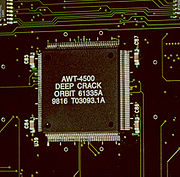
|
At the Crypto'94 conference, M.Matsui presented a DES-breaking technique
termed 'linear-cryptanalysis'.
Using 243 known ciphertexts,
he was able to determine a single DES key in 50 days on a 100MHz
desktop machine.
As the cracking process is linear,
comparable times on contemporary machines are measured in hours.
In 1998 EFF's (then) US$250,000 DES cracking machine contained
1,856 custom chips
and could brute force all 256 DES keys in 9 days.
|
CITS3002 Computer Networks, Lecture 12, Cryptography's role in networking, p10, 22nd May 2024.
DES Modes - Electronic Code Book (ECB)
Traditionally,
each block of ciphertext is independent of other blocks
and is most frequently used for the coding of data on some storage medium
(such as a disk or transmitted via a network).
DES Modes - Cipher Block Chaining (CBC)
The notion of chaining ensures that each block
is dependent on earlier blocks:
Now, an intruder can neither insert nor delete any block without detection.
Cipher block chaining is hence typically used in networking applications.
CITS3002 Computer Networks, Lecture 12, Cryptography's role in networking, p11, 22nd May 2024.
Exchanging Encryption Keys
Despite centuries of evolution of symmetric key cryptography,
the fundamental problem of secure key distribution remains:
|
"How can two people (or machines) encrypt and decrypt messages using a key if
they are not sure that the key itself is secure?"
|
Diffie-Merkle-Hellman Key exchange
In 1976 Diffie and Hellman,
from Stanford University,
wrote the paper Multi-User Cryptographic Techniques,
proposing a method of exchanging keys.
The Diffie-Hellman key exchange technique enables two active
participants (who may never have met) to agree on a new, temporary,
session key with which they will exchange a message.
Moreover, anyone eavesdropping on their agreement discussion,
will not be able to further eavesdrop on the message exchange.
A simple (physical) analogy of how keys can be exchanged:
- A wants to send a key to B.
- A puts the key in a secure box and locks it with A's padlock.
- B does not have the key to A's padlock, so instead,
- B receives the box and adds B's own padlock to the box
and returns it to A.
- A removes A's padlock with A's own key and sends
the box back to B.
- B can now remove B's own padlock and remove the key
which is now shared by A and B.
The work of Diffie and Hellman was revolutionary in the way we think about
cryptography.
Previously it was 'intuitively obvious' that the key needed to encode and
decode a message needed to be the same (or trivially related).
CITS3002 Computer Networks, Lecture 12, Cryptography's role in networking, p12, 22nd May 2024.
Public Key Cryptography
Using public key encryption we use two keys
rather than just one.
- The public key, E, may be openly published.
- The private key, D, is known only by the intended recipient.
The plan is to choose keys such that even knowing the public key does not
reveal the private key:
- A and B openly publish their public keys (viewed as algorithms)
EA and EB.
- A sends EB( Plaintextmessage ) to B.
- B calculates DB( EB( Plaintextmessage ) ) = Plaintextmessage.
- B can then reply with EA( Plaintextreply )
for A to read.
CITS3002 Computer Networks, Lecture 12, Cryptography's role in networking, p13, 22nd May 2024.
The MIT/RSA Algorithm
In 1978,
Ron Rivest, Adi Shamir, and Leonard Adleman, all of MIT,
published the imaginatively named RSA algorithm for the
generation of encryption/decryption functions from number theory.
The difficulty arises when chosing the algorithms EA and
DA
such that they are inverses of one another and yet difficult to crack.
| Key length |
Factorization times |
With 107x1GHz machines |
| 429-bits (RSA-129) |
4,600 MIPS-years |
14.5 secs |
| 512-bits |
420,000 MIPS-years |
22 minutes |
| 700-bits |
4.2 x 109 MIPS-years |
153 days |
| 1024-bits |
2.8 x 1015 MIPS-years |
280,000 years |
- We choose two very large prime numbers, p and q,
each over 100 digits.
- We define EA to be the pair (e,n) where n = pxq
(for p, q being 100 digit primes,
n will typically at least 200 decimal digits).
- We define DA to be the pair (d,n)
where (e x d) mod ( (p-1) x (q-1) ) = 1
We then use:
- Encryption function : C := Pe mod n
- Decryption function : P := Cd mod n
CITS3002 Computer Networks, Lecture 12, Cryptography's role in networking, p14, 22nd May 2024.
Asymmetric ciphers
RSA is an example of an asymmetric cipher,
employing different keys for encryption and decryption.
The relationship between keys simplifies an attack.
RSA has become ubiquitous.
It is commonly used in applications such as Microsoft
Internet Explorer and Firefox for implementing security (SSL),
within mail clients for signing and encrypting emails (S/MIME),
within payment systems,
and for encrypting traffic between VPN gateways.
Keys for asymmetric ciphers need to be longer than keys for symmetric
ciphers to achieve similar resistance to brute-force attacks:
|
Symmetric Key Length
|
Asymmetric Key Length
|
| 56 bits |
384 bits |
| 64 bits |
512 bits |
| 80 bits |
768 bits |
| 112 bits |
1792 bits |
| 128 bits |
2304 bits |
The 17-year patent on RSA was due to expire on September 20, 2000, but was
released into the public domain two weeks early on September 6, 2000.
"Because the RSA algorithm remains one of the most widely used
methods of implementing public key cryptography, the expiration of the
RSA patent is good news for software companies, e-commerce, and users
of private or secure communications. The fundamental patents on public
key cryptography have all now expired, and we should expect an explosion
of new and powerful implementations of this technology. I expect there
will be expiration parties from Palo Alto to Perth
as technology companies roll out new applications of this
important technology!"
Pat Finn, "Handbook of Intellectual Property Claims and Remedies"
|
CITS3002 Computer Networks, Lecture 12, Cryptography's role in networking, p15, 22nd May 2024.
Strong Encryption is not enough - the need for Digital Signatures
The push for eCommerce has demonstrated the need,
not for greater bandwidth, nor (strictly) for greater end-to-end security,
but for authentication and authorization
of the end players.
Digital signatures were first discussed by Diffie and Hellman in their 1976
'New Directions in Cryptography',
but eCommerce is only recently demonstrating their worth
to a wider audience (and their patent has expired!).
Unlike traditional signatures,
a digital signature cannot be a constant;
it must be a function of the document that it signs.
A digital signature prevents two types of fraud -
- the forging of a signature by the receiver (or any third party), and
- the repudiation of the transmission of a message by the sender.
Two categories of digital signature are identified:
- True signatures, signed by the sender, verified by the receiver.
- Arbitrated signature may only be sent and verified through a
trusted third party.
The recipient is unable to verify the sender's
signature directly, but is assured of its validity through
the mediation of the arbitrator.
CITS3002 Computer Networks, Lecture 12, Cryptography's role in networking, p16, 22nd May 2024.
Message Digests - basic building blocks
A message digest is a 16-, 20-, 32-byte 'fingerprint' of a message.
Message digests are central to digital signatures.
When a message is signed, its contents are first hashed to give a
message digest.
The digest is then encrypted with the sender's secret key,
giving a proof of the sender's identity.
A good digest must have the properties:
- An absence of collisions.
Unlike simpler file checksums, which quickly demonstrate file or
data integrity,
it must be hard to find two messages with the same digest.
- Must not be invertible.
Digests are deterministic many-to-one functions.
- A uniform distribution of results.
A change in just one input bit should affect at least half the output bits.
Simple changes to even a single byte (even a single bit)
should result in dramatic changes to the digest:
- The winner is Sydney
2f8eff80630eb401b0038d8df420719b
- The winner is Sydey
f2b91cf6f8ad805a127182e8a46d450f
Some popular message digests:
- MD2 and MD5: developed by RSA, producing 16-byte hashes.
Research in 1994 found weaknesses in collision frequencies.
- RIPEMD-160: The European standard
producing 20-byte hashes.
- SHA-1, SHA-2 and SHA-256 are specified by the US government
for their DSA, outputting 20-byte hashes.
From 2004:
MD5 To Be Considered Harmful Someday.
CITS3002 Computer Networks, Lecture 12, Cryptography's role in networking, p17, 22nd May 2024.
(Old) performance of the basic building blocks
Message digest algorithms
(on 233MHz Pentium-II, but speed scales linearly):
| Algorithms |
Calculation (KB/sec) |
| MD5 |
36,250 |
| SHA-1 |
20,428 |
Symmetric key algorithms (233MHz Pentium-II):
| Algorithms |
Setup (ms) |
Encryption (KB/sec) |
Decryption (KB/sec) |
| DES (56 bit) |
6.3 |
4,386 |
4,557 |
| Triple-DES (112 bit) |
22 |
1,596 |
1,620 |
| RC4 (128 bits) |
29.8 |
27,325 |
28,132 |
| RC5 (128 bit) |
352 |
4,576 |
4,691 |
Asymmetric key algorithms (233MHz Pentium-II):
|
| 512 bits (KB/s)
| 1024 bits (KB/s)
| 2048 bits (KB/s)
|
| RSA encryption |
10.5 |
4.23 |
0.436 |
| RSA decryption |
5.28 |
2.87 |
1.4 |
The command-line openssl program
provides speeds on contemporary machines:
linux> openssl
OpenSSL> speed md5
To get the most accurate results, try to run this
program when this computer is idle.
Doing md5 for 3s on 16 size blocks: 1722968 md5's in 2.80s
Doing md5 for 3s on 64 size blocks: 1469874 md5's in 2.80s
....
type 16 bytes 64 bytes 256 bytes 1024 bytes 8192 bytes
md5 9833.40k 33603.65k 92756.49k 167532.74k 217651.97k
For large amounts of data, we first encrypt the data with a symmetric
algorithm and then encrypt the symmetric key with an asymmetric algorithm.
Hybrid protocols are used in most current cryptographic architectures,
such as SSL.
CITS3002 Computer Networks, Lecture 12, Cryptography's role in networking, p18, 22nd May 2024.
Digital signature generation
Digital certificates are often confused
with digital signatures.
Like a message digest, a digital signature is a 'summary' of the
original message, but also provides an assurance that the original creator of
the signature has the private key matching the public key used to
generate the signature.
But who holds the public and private keys?
What if the public key had been replaced with another?
CITS3002 Computer Networks, Lecture 12, Cryptography's role in networking, p19, 22nd May 2024.
Digital certificates
Digital certificates have been loosely described as
the driver's license for the Internet.
A digital certificate provides a binding
between an entity's public key,
and one or more attributes to its identity.
- An entity may be a person,
a executing piece of software,
or a device such as a router or a smart-card.
- A certification authority (CA) attests to the authenticity
of the entity's public key by digitally signing a message with its
own private key.
- The 'quality' of the certificate depends on the detail of information
provided to the CA (more later).
- Either, public and private keys may be issued by the CA,
or the CA may challenge the entity's public key.
The successful use of digital certificates appears within a large community -
little is gained by issuing one's own.
CITS3002 Computer Networks, Lecture 12, Cryptography's role in networking, p20, 22nd May 2024.
Digital certificate encoding
Today, certificates are defined by the ISO X.509 protocol
and appears as an application/x-x509-user-cert MIME type.
The data is encoded using Abstract Syntax Notation (ASN.1), encoding
and transmitted in ASCII using
base64 encoding.
(18bit data -> 24bit representation).
Early debate centred on whether the certificate itself needed to be
encrypted (now not).
CITS3002 Computer Networks, Lecture 12, Cryptography's role in networking, p21, 22nd May 2024.
Browser support for digital certificates
Digital certificates are managed by all common browsers:
Firefox,
Safari,
Opera,
Netscape Navigator,
Microsoft Internet Explorer ...
If visiting a site with the secure Hypertext Transport Protocol,
as with
https://secure.csse.uwa.edu.au/
we can view digital certificate information via the 'padlocked' icon.
Unfortunately, there are often few CAs from Australia in most common browsers.
CITS3002 Computer Networks, Lecture 12, Cryptography's role in networking, p22, 22nd May 2024.
Browser support for digital certificates
|
|
The browser will display the digital certificate from the current page -
here showing:
- The subject of the certificate,
- The issuer (CA) of the certificate,
- The serial number of the certificate,
- The period of validity of the certificate, and
- The message digest of certificate.
If the issuer of a site's digital certificate is already known by the
browser (either 'hard-wired' or manually added),
the issuer's certificate may be viewed and verified.
Version 3 of X.509 introduced extension fields -
the association of additional information with a certificate.
Each extension has:
- an extension type
providing semantics and typing of the extension (e.g. a string),
- an extension value",
such as an email or IP address, and
- a criticality indicator
indicating if the whole certificate should be ignored if an extension is
not recognized.
Standard extensions (?) now describe the 'strength' and purpose of the
certificate -
digital signature,
non-repudiation,
key encipherment,
data encipherment,
certificate signing, etc.
|
CITS3002 Computer Networks, Lecture 12, Cryptography's role in networking, p23, 22nd May 2024.
Certificate Path validation
CAs are organized in hierarchies - each parent CA signs a
certificate vouching for a subordinate CA's public key.
When validating a chain of certificates,
the certificate path,
the path is followed until the top of the chain is reached (when?).
There is no automated way of verifying the top of a certificate chain
other than verifying that it is one of a list of directly known (and
implicitly trusted) certificates (such as in a browser).
Several companies,
such as VeriSign, Thwaite, Baltimore, AT&T,
and a growing band of government departments
have positioned themselves 'at the top'.
CITS3002 Computer Networks, Lecture 12, Cryptography's role in networking, p24, 22nd May 2024.
Certificate Revocation Lists
A certificate revocation list (CRL)
allows clients and servers to check whether the entity they are
dealing with has a valid certificate.
|
|
Trust breaks down, and CRLs are required, when:
- a subject's private key is exposed,
- a CA's private key is exposed, and
- the relationship between the subject and CA changes
(e.g. the subject is no longer employed by the CA,
or stops paying money to the CA).
Certificate revocation plays a crucial part in the authentication process:
- Obtain the subject's digital certificate and verify its validity.
- Extract the serial number of the certificate.
- Fetch the current CRL from the CA.
- Verify the CRL's digital signature,
and record its publication time and when the next CRL is to be published.
- Examine the CRL to determine if the intended certificate
been revoked or suspended (based on the certificate serial number).
- Alert the user if the certificate is revoked.
Limitations of Certificate Revocation
In a large public key infrastructure community,
CRLs are both large and must be downloaded frequently.
Applications can be significantly slowed by the
need to retrieve the latest CRL from a heavily taxed directory server
(or other distribution point).
There exists a compromise between always being up-to-date,
versus the risk of false certificate acceptance.
|
CITS3002 Computer Networks, Lecture 12, Cryptography's role in networking, p25, 22nd May 2024.
|


 CITS3002
CITS3002 help3002
help3002 CITS3002 schedule
CITS3002 schedule